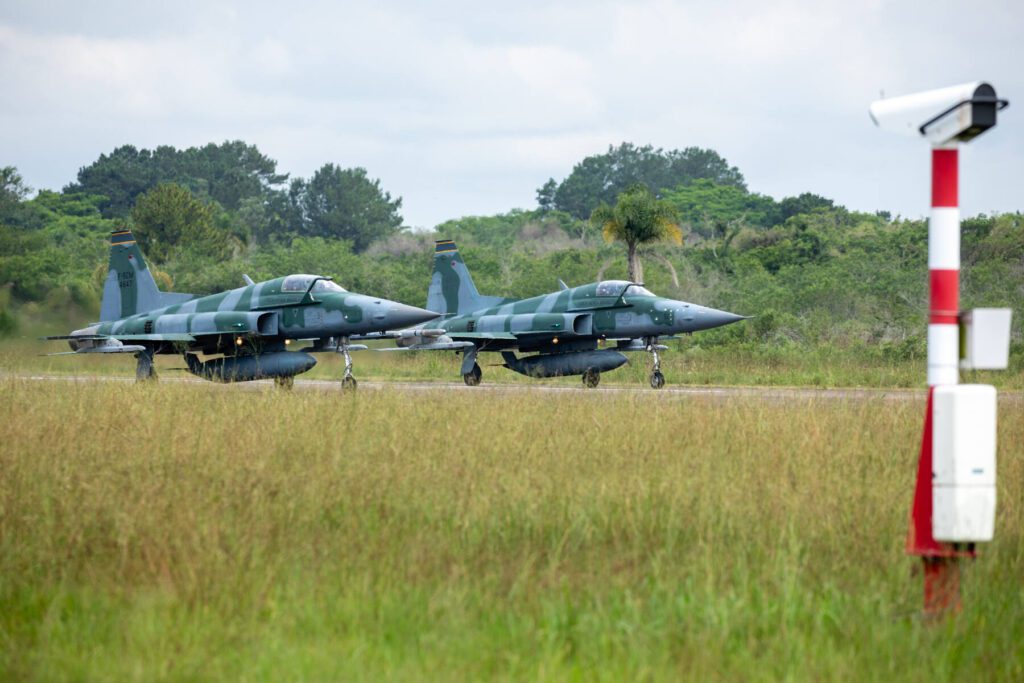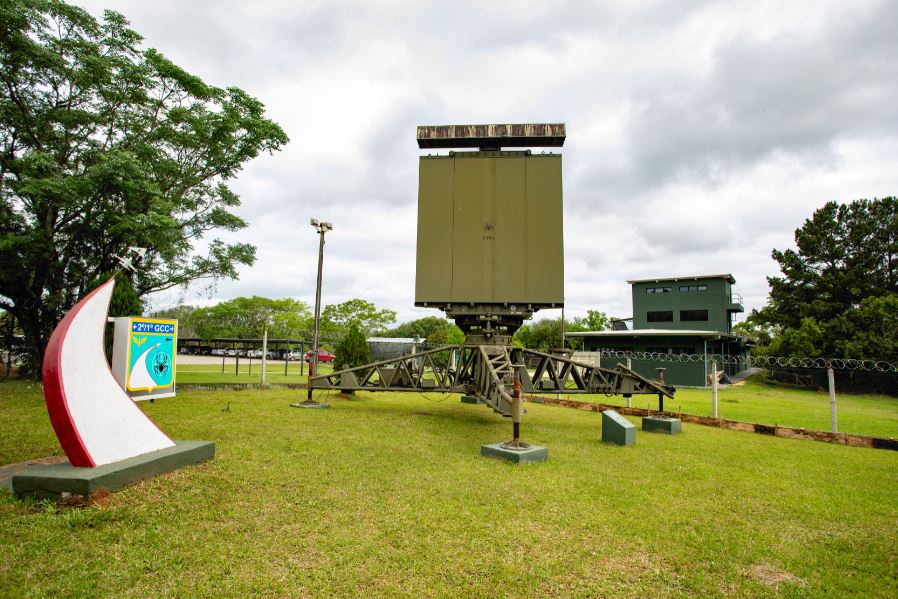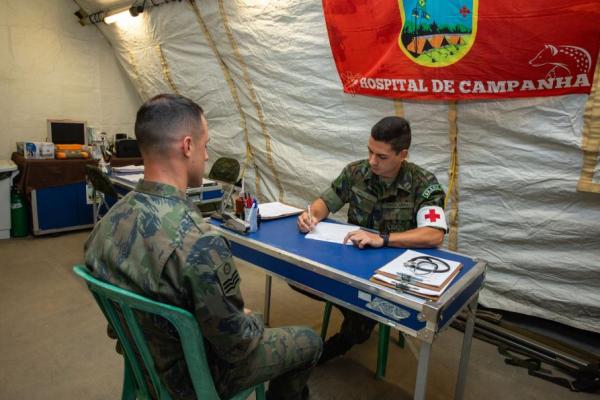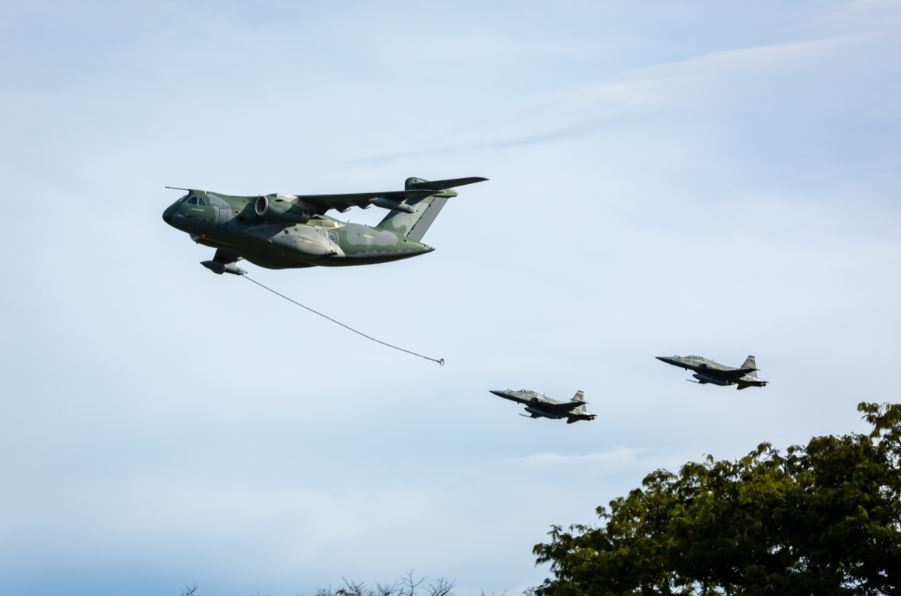More than 1,200 military personnel worked on COMAO missions, with a strong differential: training in multidomain operations
Air Force Agency, by Lieutenant Myrea Calazans
Fighter, Intelligence, Surveillance and Reconnaissance, Rotary Wing and Transport. The activities of the more than 30 aircraft from the different aviations employed in Joint Exercise Shield-Tinia 2023 came to an end on Friday (17/11). With different profiles and specific doctrines, but acting in coordination and mutual support, the vectors totaled more than 500 flight hours in training, with a focus on COMAO missions.
With the common objective of carrying out complementary air force actions to ensure air superiority in a conventional and regular war scenario in the Pampas Gaúchos, the more than 1,200 military personnel involved in the training acted in COMAO missions, but with a strong difference this year: training in multidomain operations, which includes air, land, sea, space and cyber.
To give an idea of the complexity of this edition, with regard to the space scenario, for example, it was possible to use more than 90 satellite images recorded at different weather stations. The records strengthened the capabilities to carry out search, surveillance and change detection activities continuously during the Operation, in order to develop satellite Intelligence, Surveillance and Reconnaissance expertise to provide readiness and precision in the delivery of essential information.
“Before the start of the exercise, EXCON’s Space cell was already monitoring logistical activities in important areas for the deployment of troops and Anti-Aircraft Artillery (AAAe) assets. The effectiveness of using our space assets was demonstrated when they were used prior to surface and air operations. Changes were detected in these areas, which served as warnings to mission planners, within the context of Tinia,” said the representative of the Third Subchief of the Air Force General Staff (EMAER), Lieutenant Colonel Rafael Lemos Paes.
In the air, the pilots faced a new challenge: to operate offensively and defensively, this time in more equal proportions, sometimes as an opposing force and sometimes as an attacking force in the same operation. On the ground, multidomain operations were also present. In the “Shield” context, for example, under the coordination of the Aerospace Operations Command (COMAE), various simulations were carried out, such as the cyber attack on the FAB’s Infantry Units (UInf) and the Anti-Aircraft Artillery Groups (GAAAe) of the three Armed Forces, which were stationed in Santana da Boa Vista (RS), in the interior of Rio Grande do Sul.

Logistical support for anti-aircraft defense
Around 350 soldiers from the FAB’s Infantry Units and the Anti-Aircraft Artillery Groups of the three Armed Forces, stationed in Santana da Boa Vista (RS), were supported by the Mobile Support Squadron (EMA), with accommodation, food, sanitation, communications, security and health. “In this context, more than 20,000 meals were provided during the exercise, 294 emergency health services and 191 dental services. We certainly ensured that the well-being of the troops was always maximized, so that our soldiers could carry out the training proposed by EXCON with excellence,” said the EMA Commander, Major Rafael Freitas de Lima.

Operational Performance Assessment Cell (CADO)
Among the activities carried out in the structure set up in the Second Fleet of the First Communications and Control Group (2º/1º GCC) – Aranha Squadron was the Operational Performance Evaluation Cell (CADO), responsible for the process of evaluating and validating air and ground operational activities. The aim was to collect and analyze operational employment data in order to measure capabilities and, consequently, improve the training of the teams employed in the training. The actions carried out in the Cell included the integration of military personnel from the Airspace Control Department (DECEA) and the Preparedness Command (COMPREP).
“Our main task is to coordinate with the air units to define the flight profiles that are interesting, the attack modes and the flight level. With all this information, we coordinate so that the exercise evolves in terms of complexity, so that the teams can train from the most basic levels to the most complex situations in which an incursion can occur,” said the Anti-Aircraft Defense Coordinator of the Exercise Directorate (DIREX), Infantry Major Vinicius Ramalho e Souza.

Air Traffic Control
EXCON Escudo-Tínia 2023 also relied on a complex telecommunications infrastructure and a great deal of planning and training of participants from various multidisciplinary specialties to carry out Air Traffic Control activities. To this end, the TPS-B34 Air Defense Radar, based at the 2nd/1st GCC, was used. Its main advantage is that it is three-dimensional, transportable and has enormous electronic warfare capabilities.

Results
The Commander of the Fifth Regional Air Command (V COMAR), Major General Marcelo Fornasiari Rivero, described the success of EXCON Escudo-Tínia 2023 in terms of other major FAB operations. “In this edition, it was possible to incorporate new technologies that will be applied in future operations, such as Cruzex, for example,” he said.
In addition, the Commander of Canoas Air Base (BACO) and Director of the Exercise, Colonel Marcelo Zampier Bussmann, highlighted important aspects of this year’s innovation. “The Shield-Tinia Joint Exercise is coming to an end with its objectives achieved, especially with the application of multidomain actions. In addition, the interoperability between the FAB, the Brazilian Army and the Brazilian Navy in airspace defense actions has been consolidated,” he concluded.
Video: Sergeant Lucas / CECOMSAER – Photos: Sergeants Muller Marin and P. Silva / CECOMSAER
